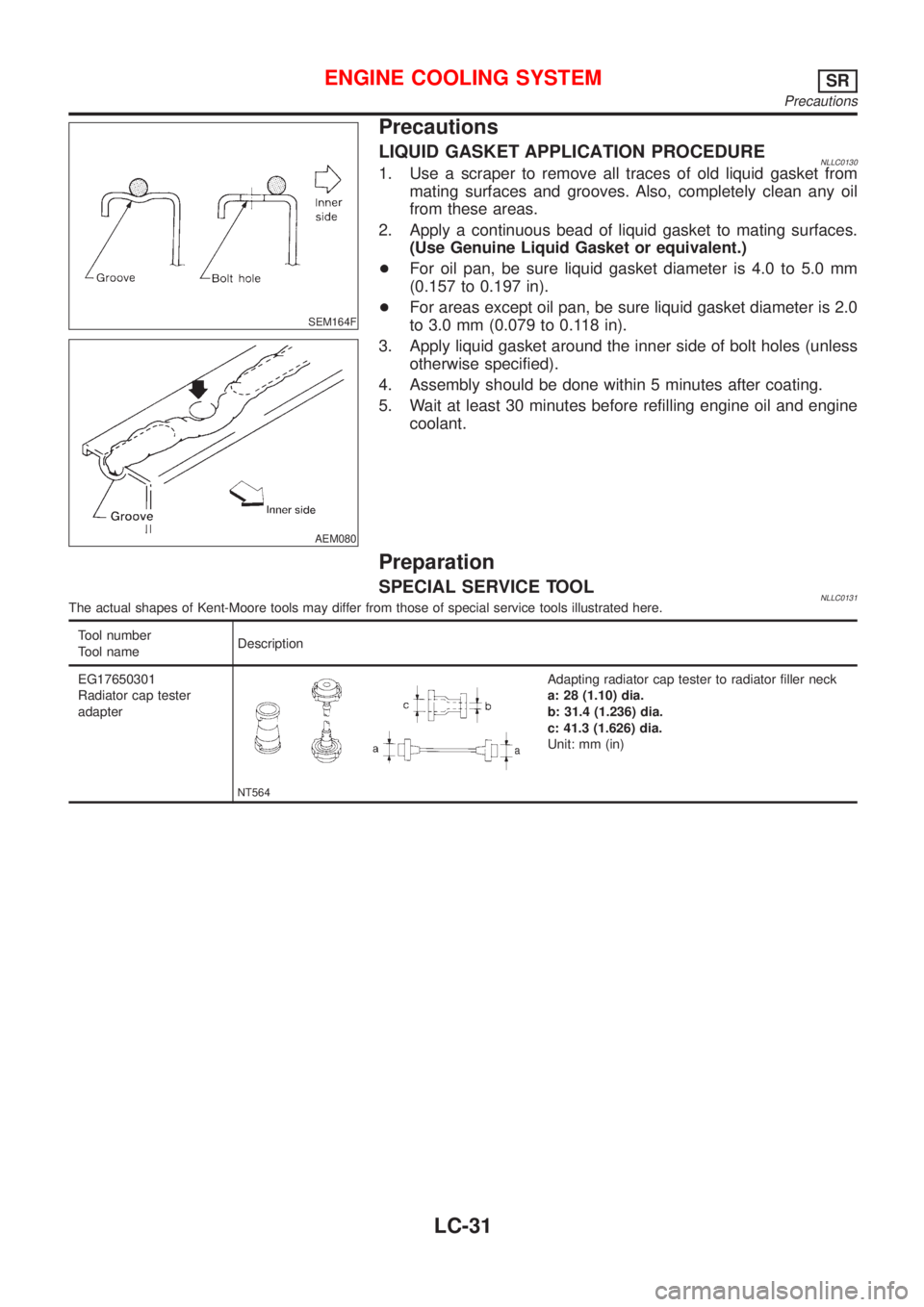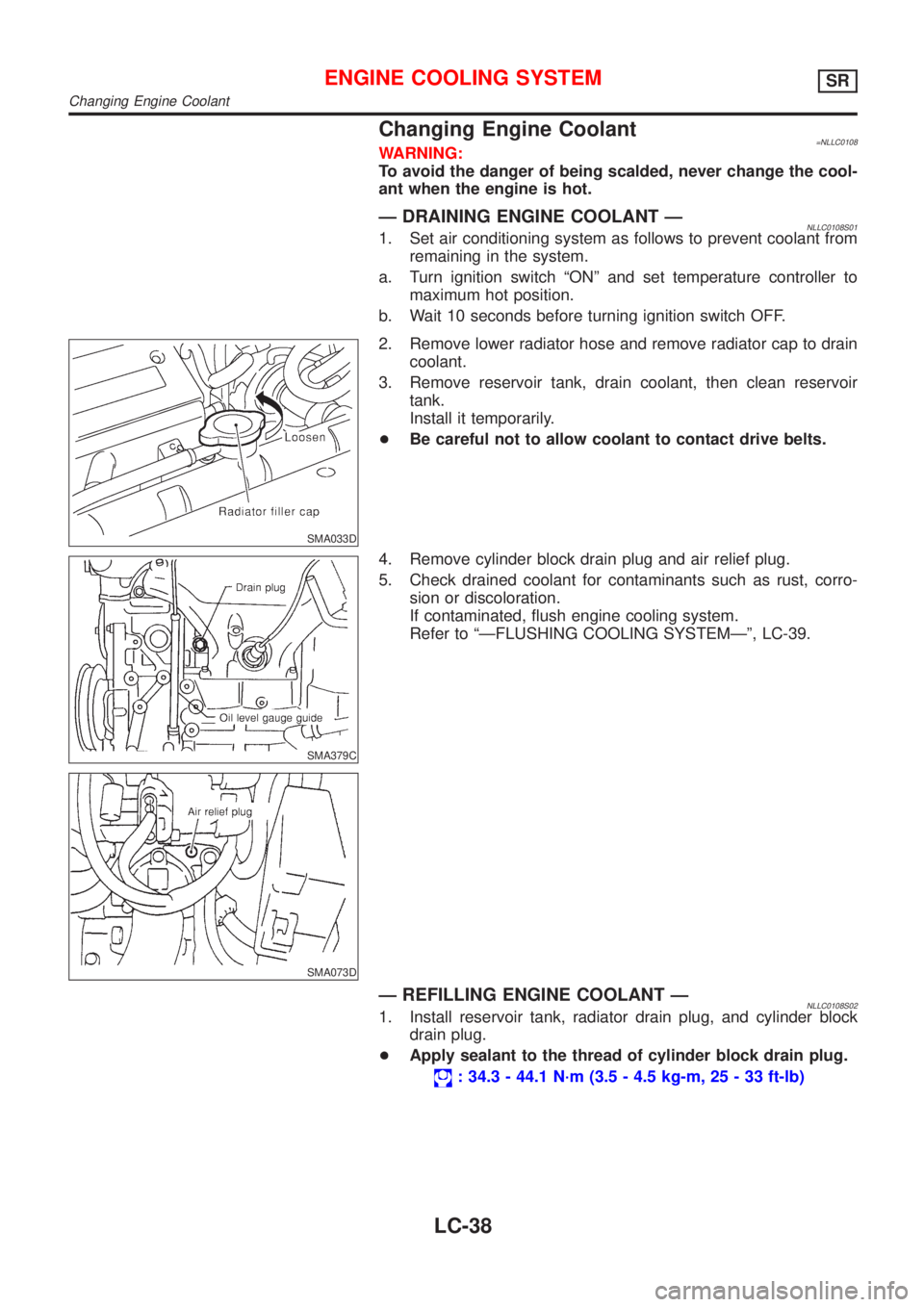Page 2734 of 3051

SEM164F
AEM080
Precautions
LIQUID GASKET APPLICATION PROCEDURENLLC01301. Use a scraper to remove all traces of old liquid gasket from
mating surfaces and grooves. Also, completely clean any oil
from these areas.
2. Apply a continuous bead of liquid gasket to mating surfaces.
(Use Genuine Liquid Gasket or equivalent.)
+For oil pan, be sure liquid gasket diameter is 4.0 to 5.0 mm
(0.157 to 0.197 in).
+For areas except oil pan, be sure liquid gasket diameter is 2.0
to 3.0 mm (0.079 to 0.118 in).
3. Apply liquid gasket around the inner side of bolt holes (unless
otherwise specified).
4. Assembly should be done within 5 minutes after coating.
5. Wait at least 30 minutes before refilling engine oil and engine
coolant.
Preparation
SPECIAL SERVICE TOOLNLLC0131The actual shapes of Kent-Moore tools may differ from those of special service tools illustrated here.
Tool number
Tool nameDescription
EG17650301
Radiator cap tester
adapter
NT564
Adapting radiator cap tester to radiator filler neck
a: 28 (1.10) dia.
b: 31.4 (1.236) dia.
c: 41.3 (1.626) dia.
Unit: mm (in)
ENGINE COOLING SYSTEMSR
Precautions
LC-31
Page 2735 of 3051
Cooling CircuitNLLC0132
NLC087
System CheckNLLC0133WARNING:
Never remove the radiator cap when the engine is hot. Serious
burns could occur from high pressure coolant escaping from
the radiator.
Wrap a thick cloth around the cap. Slowly turn it a quarter turn
to allow built-up pressure to escape. Carefully remove the cap
by turning it all the way.
CHECKING COOLING SYSTEM HOSESNLLC0133S01Check hoses for the following:
+Improper attachment
+Leaks
+Cracks
+Damage
+Chafing
+Deterioration
SLC546AA
CHECKING COOLING SYSTEM FOR LEAKSNLLC0133S02To check for leakage, apply pressure to the cooling system with a
tester.
Testing pressure:
157 kPa (1.6 kg/cm
2, 23 psi)
CAUTION:
Higher pressure than specified may cause radiator damage.
ENGINE COOLING SYSTEMSR
Cooling Circuit
LC-32
Page 2736 of 3051

CHECKING RADIATORNLLC0133S03Check radiator for mud or clogging. If necessary, clean radiator as
follows.
+Be careful not to bend or damage the radiator fins.
+When radiator is cleaned without removal, remove all sur-
rounding parts such as cooling fan, rediator shroud and horns.
Then tape the harness and connectors to prevent water from
entering.
1. Apply water by hose to the back side of the radiator core ver-
tically download.
2. Apply water again to all radiator core surfaces once per
minute.
3. Stop washing if any stains no longer flow out from the radia-
tor.
4. Blow air into the back side of radiator core vertically download.
+Use compressesd air lower than 490 kPa (5 kg/cm
2, 71 psi)
and keep distance more than 30 cm (11.8 in).
5. Blow air again into all the radiator core surfaces once per
minute until no water sprays out.
SLC613-A
CHECKING RADIATOR CAPNLLC0133S04To check radiator cap, apply pressure to cap with a tester.
Radiator cap relief pressure:
Standard
78 - 98 kPa (0.8 - 1.0 kg/cm
2, 11 - 14 psi)
Limit
59 - 98 kPa (0.6 - 1.0 kg/cm
2,9-14psi)
SMA967B
Pull the negative pressure valve to open it.
Check that it closes completely when released.
SLC266B
Water Pump
REMOVAL AND INSTALLATIONNLLC01271. Drain coolant from radiator.
2. Remove cylinder block drain plug located at left front of cylin-
der block and drain coolant.
3. Remove front RH wheel and engine side cover.
4. Remove drive belts. Refer to EM-86, ªChecking Drive Beltsº.
5. Remove RH engine mounting. Refer to EM-131, ªENGINE
REMOVALº.
ENGINE COOLING SYSTEMSR
System Check (Cont'd)
LC-33
Page 2737 of 3051
SLC556AB
6. Remove water pump.
CAUTION:
+When removing water pump assembly, be careful not to
get coolant on drive belt.
+Water pump cannot be disassembled and should be
replaced as a unit.
+After installing water pump, connect hose and clamp
securely, then check for leaks using radiator cap tester.
SLC433A
7. Use a scraper to remove liquid gasket from water pump.
+Also remove traces of liquid gasket from mating surface
of cylinder block.
SLC434AA
8. Apply a continuous bead of liquid gasket to mating surface of
water pump.
+Use Genuine Liquid Gasket or equivalent.
When filling radiator with coolant, refer to LC-38, ªChanging
Engine Coolantº.
When installing drive belts, refer to EM-86, ªChecking Drive
Beltsº.
9. Install any parts removed in reverse order of removal.
SLC408C
INSPECTIONNLLC0128+Check body assembly for rust or corrosion.
+Check for rough operation due to excessive end play.
ENGINE COOLING SYSTEMSR
Water Pump (Cont'd)
LC-34
Page 2738 of 3051
Thermostat
REMOVAL AND INSTALLATIONNLLC0134
SLC267B
Be careful not to spill coolant over engine compartment. Use
a rag to absorb coolant.
1. Drain engine coolant.
2. Remove lower radiator hose.
3. Remove water inlet, then take out thermostat.
SLC767
4. Install thermostat with jiggle valve or air bleeder at upper side.
+Apply a continuous bead of liquid gasket to mating sur-
face of water inlet.
+After installation, run engine for a few minutes, and check
for leaks.
ENGINE COOLING SYSTEMSR
Thermostat
LC-35
Page 2739 of 3051
SLC343
INSPECTIONNLLC01351. Check for valve seating condition at normal room temperature.
It should seat tightly.
2. Check valve opening temperature and valve lift.
Valve opening temperature ÉC (ÉF) 82 (180)
Valve lift mm/ÉC (in/ÉF) More than 8/95 (0.31/203)
3. Then check if valve closes at 5ÉC (9ÉF) below valve opening
temperature.
SLC268B
Water Outlet
INSPECTIONNLLC0136Visually inspect for water leaks. If there is leakage, apply liquid
gasket.
BLC004
INSTALLATIONNLLC01371. Use a scraper to remove old liquid gasket from water outlet.
+Also remove traces of liquid gasket from mating surface
of cylinder head.
2. Apply a continuous bead of liquid gasket to mating surface of
water outlet.
+Use Genuine Liquid Gasket or equivalent.
+When installing, tighten water outlet bolts to the specified
torque.
: 6.3 - 8.3 N´m (0.64 - 0.85 kg-m, 55.6 - 73.8 in-lb)
ENGINE COOLING SYSTEMSR
Thermostat (Cont'd)
LC-36
Page 2740 of 3051
Radiator
COMPONENTSNLLC0138
NLC093
Cooling Fan Control SystemNLLC0139Cooling fans are controlled by the ECM. For details, refer to
EC-887, ªCooling Fanº.
ENGINE COOLING SYSTEMSR
Radiator
LC-37
Page 2741 of 3051

Changing Engine Coolant=NLLC0108WARNING:
To avoid the danger of being scalded, never change the cool-
ant when the engine is hot.
Ð DRAINING ENGINE COOLANT ÐNLLC0108S011. Set air conditioning system as follows to prevent coolant from
remaining in the system.
a. Turn ignition switch ªONº and set temperature controller to
maximum hot position.
b. Wait 10 seconds before turning ignition switch OFF.
SMA033D
2. Remove lower radiator hose and remove radiator cap to drain
coolant.
3. Remove reservoir tank, drain coolant, then clean reservoir
tank.
Install it temporarily.
+Be careful not to allow coolant to contact drive belts.
SMA379C
SMA073D
4. Remove cylinder block drain plug and air relief plug.
5. Check drained coolant for contaminants such as rust, corro-
sion or discoloration.
If contaminated, flush engine cooling system.
Refer to ªÐFLUSHING COOLING SYSTEMк, LC-39.
Ð REFILLING ENGINE COOLANT ÐNLLC0108S021. Install reservoir tank, radiator drain plug, and cylinder block
drain plug.
+Apply sealant to the thread of cylinder block drain plug.
: 34.3 - 44.1 N´m (3.5 - 4.5 kg-m, 25 - 33 ft-lb)
ENGINE COOLING SYSTEMSR
Changing Engine Coolant
LC-38